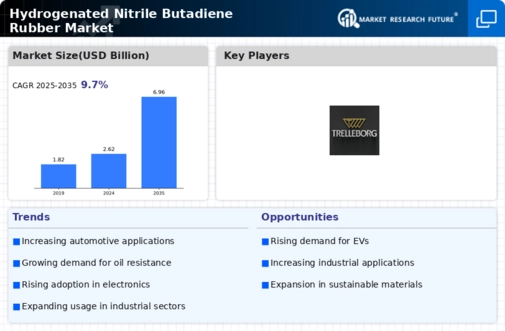Market Analysis
In-depth Analysis of Hydrogenated Nitrile Butadiene Rubber Market Industry Landscape
The global market for high-performance materials is expected to grow significantly, around 7% each year from 2016 to 2023. This growth is mainly driven by the automotive industry's need for lightweight materials to improve fuel efficiency in vehicles. Strict regulations, like the Corporate Average Fuel Economy (CAFE) in North America, have pushed car manufacturers to reduce the weight of vehicles. This has increased the demand for a material called HNBR, particularly in making parts for car engines.
HNBR is used in various vehicle and machine parts like transmission belts, hoses, oil seals, gaskets, O-rings, V-belts, printers' rollers, and cable jacketing. In the automotive industry, it finds applications in timing belts, diaphragms, boots, and shaft seals. As the trend is to decrease engine bay space for lighter vehicles, the engine temperature rises. HNBR, being able to withstand high temperatures for a long time, becomes essential for the automotive industry. The increase in vehicle operating temperatures has led to the development of harsh fluids like engine oils and lubricants. This, in turn, requires special materials with superior heat, fluid, and chemical resistance, making HNBR a suitable choice.
HNBR's remarkable properties, such as resistance to high and low temperatures, oils and solvents, and resistance to ozone and weather conditions, along with its mechanical strength, make it highly desirable for use in automotive engines and machinery. The growing demand for HNBR in the automotive industry is driven by its ability to address key challenges faced by manufacturers. With a focus on reducing vehicle weight to meet fuel efficiency and emission standards, HNBR emerges as a versatile solution due to its lightweight nature and exceptional durability. As automotive designs evolve, engine bays are shrinking, leading to higher temperatures. HNBR's resilience in extreme heat conditions positions it as an ideal material for critical engine components, ensuring reliable performance under challenging circumstances.
Moreover, the automotive industry's transition towards harsher operating conditions, including the use of aggressive fluids like engine oils, demands materials with enhanced resistance. HNBR's resistance to oils, solvents, and various chemicals aligns perfectly with these requirements, contributing to its widespread adoption.




Leave a Comment